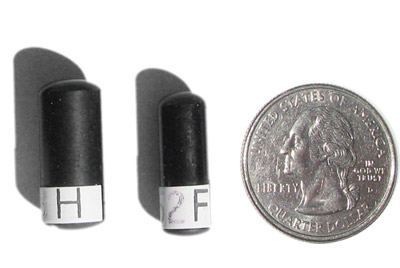
Tags from left to right:
Coded V9 and Coded V7
Overview
The ultrasonic tags used for this telemetry project are coded beacons, available from Vemco Ltd. of Halifax, Canada, which emit pulse bursts on a single frequency of 69 kHz. The identity of each ultrasonic tag is encoded by distinct separations between the eight pulses transmitted, making up the pulse train or signal a tag transmits. The interval between the first two pulses designates the number of tag permutations. Hence, a 4K tag has 210 or 4096 unique combinations; a 64K tag has 214 or 65,536 combinations. The next four intervals encode the numerical identity of the tag. The last two intervals perform error checking, and ensure that each tag has the correct code. This coding scheme enables each tag to have a unique coded identity. The receiver in the monitor measures the different separation times, decodes the identity of the tag, and places the corresponding tag ID along with time and date of detection in the memory of the automated VR2 monitor. The type of coded tag utilized is determined by the size of the study organism, desired battery life, and output strength. Typically, V7 tags are used for juvenile chinook, V9's for juvenile steelhead and V16's for adult green sturgeon and steelhead kelts. A tag can be programmed to remain inactive during a preset period of time to conserve battery life during the designated holding period. Tags are also programmed to transmit their pulse train at random time intervals in order to minimize tag collisions that interfere with detection by monitors.